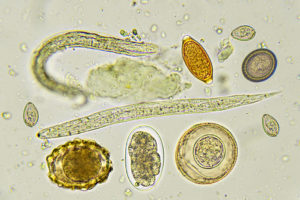check yourself
Fill in these summary tables to check your learning.
Tapeworms
Segmented flat worms.
Taenia sagniata (Beef tapeworm)
Humans ingest undercooked beef containing cysticerci, larvae attach to bowel wall and mature to adult worms that eventually shed proglottids into feces that are eaten by cattle. Humans are the definitive host, and cows the intermediate host. Clinically, infection is usually asymptomatic except mild abdominal discomfort, as with most other adult tapeworms. Cysticercosis in humans does not occur.
- Dx: Find proglottids or longer segment of the worm in stool. Find eggs in stool O&P (same appearance as T. solium).
- Rx: Praziquantel
Taenia solium (Pork tapeworm)
Humans develop disease depending on what stage of the organism is ingested. When ingesting undercooked pork containing cysticerci larvae attach to bowel wall and mature to adult worms that eventually shed proglottids into feces that are eaten by pork or other humans—this is taeniasis, or tapeworm, similar to beef tapeworm and is relatively asymptomatic.
When humans ingest eggs (fecal-oral route), oncospheres burrow into blood vessels in the gut lumen then disseminate to organs—causing cysticercosis. CNS and eyes are common locations. Humans are the definitive host in taeniasis and are the intermediate host in cysticercosis.
- Dx: Intestinal tapeworm = gravid proglottids in stool. Cysticercosis is diagnosed with combination of serology, radiographic findings, +/– biopsy.
- Rx: Praziquantel
See also in the Micro-ID session guide
Diphyllobothrium latum (Fish tapeworm)
Humans develop infection when ingesting raw, pickled, or undercooked freshwater fish containing larvae. Larvae attach to gut wall and become adults, passing gravid proglottids and eggs into feces. Humans and fish-eating mammals are the definitive host with small crustaceans and fish as the intermediate hosts. Generally asymptomatic, but associated with B12 deficiency due to competition for the nutrient with the worm (one of the causes of a macrocytic anemia).
- Dx: Gravid proglottids in stool have centrally positioned, rosette-shaped uterus.
- Rx: Praziquantel
See also in the Micro-ID session guide
Echinococcus/Hydatid disease
E. granulosus: Dog tapeworm; E. multilocularis: Arctic/subarctic.
Dogs and foxes are the definitive host when they ingest entrails of sheep (intermediate hosts) containing hydatid cysts. Adult worms develop in gut of dogs and shed eggs into feces. Humans are intermediate hosts when eggs are ingested. Eggs hatch in gut and migrate through blood to various organs, with liver and lung most common. Larvae form large, unilocular hydatid cysts containing many protoscolices and daughter cysts. Cysts can cause symptoms from mass effect. Ruptured cyst can cause acute anaphylaxis due to overwhelming antigen exposure.
- Dx: Imaging that shows cysts with “daughter cysts” or “hydatid sand” is diagnostic.
- Prevention: Don’t feed sheep viscera to dogs. Food-handling hygiene.
- Tx: Albendazole +/– Local injection of cyst with ethanol. Careful surgical excision.


